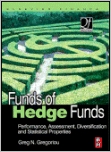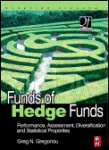|
 
FOUND OF HEDGE FUNDS
GREGORIOU G. wydawnictwo: BH, 2006, wydanie I cena netto: 365.00 Twoja cena 346,75 zł + 5% vat - dodaj do koszyka Greg Gregoriou, Associate Professor of Finance and Coordinator of
Faculty Research, School of Business and Economics, State University of New York,
Plattsburgh
Description
With about $450 billion in assets, funds of hedge funds are the most recent darling of
investors. While hedge funds carry high risk for the promise of high returns they are
designed for the very rich and for large institutional investors such as pension funds. A
Fund of Hedge Funds (FOF) spreads investments among a number of hedge funds to reduce risk
and provide diversification, while maintaining the potential for higher than average
returns. Odds are that some pension fund of yours is invested heavily in these products,
and more recently these FOFs have been opened to more and more individual investors in
offshore jurisdictions with lower minimum entry levels. Since this is a new and extremely
fast-moving financial phenomenon, academic research has just begun in earnest, and this is
the first book to present rigorous academic research by some of the leading lights in
academic finance, carefully analyzing the broad array of issues involved in FOFs.
Table of Contents
Preface and Acknowledgments About the editor List of contributors Part One Performance 1
Rank alpha funds of hedge funds Carol Alexander and Anca Dimitriu 1.1 Introduction 1.2
Hedge fund data and biases 1.3 Factor models for hedge funds 1.4 Model estimation 1.5 Rank
alpha 1.6 Optimising funds of hedge funds 1.7 Cleaning the covariance matrix 1.8
Performance analysis of rank alpha portfolios 1.9 Conclusion References 2 Funds of hedge
funds: bias and persistence in returns Daniel Capocci and Georgers Hubner 2.1 Introduction
2.2 Database 2.3 Methodology 2.4 Descriptive statistics 2.5.1 Bias analysis 2.5.2
Survivorship bias 2.5.3 Instant return history bias 2.6 Persistence in performance 2.6.1
Persistence in performance based on past performance 2.6.2 Persistence in performance
based on past risk measures 2.7 Conclusion References 3 Replication and evaluation of fund
of funds returns 1994-2005 Harry M. Kat and Helder P. Palaro 3.1 Introduction 3.2 The KP
efficiency measure 3.3 Evaluation results 3.4 Distributional analysis 3.5 Conclusion
References 4 Factor decomposition of fund of funds returns Jean-Francois Bacmann, Pierre
Jeanneret, and Stefan Scholz 4.1 Introduction 4.2 Experimental framework 4.3 Factor model
for fund of funds 4.4 Sample formation 4.5 Performance decomposition of FOF portfolios 4.6
Principal components of FOF returns 4.7 Conclusion References 5 Optimal fund of fund asset
allocation: hedge funds, CTAs and REITs Nicolas Papageorgiou and Alain Elkaim 5.1
Introduction 5.2 Data 5.3 The methodology 5.4 Results 5.5 Conclusion References 6 The
changing performance and factor risks of fund of funds in the modern period Keith H. Black
6.1 Characteristics of funds of funds 6.2 Comparing returns: funds of funds vs. hedge
funds 6.3 Ancient history vs. modern history: LTCM as the defining moment 6.4 Factor
analysis of returns 6.5 The future of funds of funds References 7 Hedge fund indices: are
they cost-effective alternatives to fund of funds? Kathryn Wilkens 7.1 Introduction 7.2
Fund of funds 7.3 Investable hedge fund indices 7.4 Distribution of returns and potential
biases 7.5 Asset based style factors 7.6 Mean excess return and Sharpe ratio comparisons
7.7 Fung and Hsieh model alphas and information ratio comparisons 7.8 Correlation with
traditional asset returns and lagged equity return comparisons 7.9 Conclusion References 8
Simple hedge fund strategies as an alternative to funds of funds: evidence from large cap
funds Greg N. Gregoriou, Georges Hubner, Nicolas Papageorgiou, and Fabrice Rouah 8.1
Introduction 8.2 Data 8.3 Methodology 8.4 Empirical results 8.5 Conclusion References Part
Two Diversification, Selection, Allocation and Hedge Fund Indices 9 Funds of funds of
hedge funds: welcome to diworsification Francois-Serge Lhabitant and Nicolas Laporte 9.1
Introduction 9.2 The art and science of diversification 9.3 Analysis 9.4 Diversification
results 9.5 How about the fees? 9.6 Conclusion References 10 Style analysis of funds of
hedge funds: measurement of asset allocation and style drift Andreas Oehler and Oliver A.
Schwindler 10.1 Introduction 10.2 Sharpe?s model for style analysis 10.3 Data set 10.4
Hedge fund classification 10.5 Accuracy of Sharpe?s model 10.6 Measuring the style drift
10.7 Conclusion References 11 Gains from adding funds of hedge funds to portfolios of
traditional assets: An international perspective Niclas Hagelin, Bengt Pramborg, and
Fredrik Stenberg 11.1 Introduction 11.2 Data 11.3 Method 11.4 Results 11.5 Conclusion
References 12 Tactical asset allocation for hedge fund indices at one- to six-month
horizons Laurent Favre 12.1 Introduction 12.2 The Model 12.3 The results 12.4 Conclusion
References 13 Single strategy funds of hedge funds: how many funds? Ryan J. Davies, Harry
M. Kat, and Sa Lu 13.1 Introduction 13.2 Decomposition 13.3 Conclusion References Part
Three Construction, and Statistical Properties of Funds of Hedge Funds 14 The
distributional characteristics of fund of hedge fund returns Elaine Hutson, Margaret Lynch
and Max Stevenson 14.1 Introduction 14.2 Hedge funds: background 14.3 Testing for
normality 14.4 Data and summary performance information14.5 Results 14.6 Conclusion
References 15 Funds of funds and diversification effect Maher Kooli 15.1 Introduction 15.2
Mean-variance spanning tests 15.3 Data description 15.4 Empirical results 15.5 Conclusion
References 16 Higher-moment performance characteristics of funds of funds Zsolt Berenyi
16.1 Introduction 16.2 Performance assessment basics 16.3 Data and methodology 16.4
Performance characteristics of funds of funds 16.5 Enhancing FOF performance 16.6 Results
16.7 Conclusion References 17 The market risk of funds of hedge funds: a conditional
approach Florent Pochon and Jerome Te?letche 17.1 Introduction 17.2 Implications for hedge
funds returns modelling 17.3 An application to stress testing 17.4 Conclusion References
18 Revisiting the Fama and French model: An application to funds of funds using nonlinear
methods Eric Dube, Clement Gignac and Francois Eric Racicot 18.1 Introduction 18.2
Methodology 18.3 Data 18.4 Results 18.5 Conclusion References 19 Investor?s choice: an
investor-driven, forward-looking optimization approach to fund of hedge fund construction
Clemens H. Glaffig 19.1 Introduction 19.2 The data set: defining market patterns 19.3 The
methodology: investor-driven objectives and the optimization algorithm 19.4 Empirical
analysis: exhibiting the new degrees of freedom 19.5 Conclusion Reference Part Four
Monitoring Risk, Overview of FOFs, Due Diligence, and Special Classes of Funds of Funds 20
Moments analysis in risk and performance monitoring of funds of hedge funds David K.C.
Lee, Kok Fai Phoon, and Choon Yuan Wong 20.1 Introduction 20.2 Funds of hedge funds 20.3
Investing in funds of hedge funds – a practical approach 20.4 Data description,
empirical analysis and results 20.5 Analysis of trade-off 20.6 Conclusion References 21 An
overview of funds of hedge funds Jean Brunel 21.1 Introduction 21.2 Creating a portfolio
of hedge funds 21.3 Ongoing portfolio management 21.4 Returning to the problem of the
individual investor 21.5 Tracking funds of funds 21.6 Conclusion References 22
Institutional investment due diligence on funds of hedge funds John E. Dunn, III 22.1
Introduction 22.2 The gap: fiduciary responsible investing vs. private client products
22.3 Exploring institutional fiduciary responsibility 22.4 Exploring fiduciary
responsibility: what IBM has that the average hedge fund of fund needs to incorporate 22.5
Conclusion References 23 Synthetic CDO squares and the continuing evolution of funds of
funds Paul Ali 23.1 Introduction 23.2 Development of synthetic CDO squares 23.3 Structure
of synthetic CDO squares 23.4 Recharacterisation risk 23.5 Conclusion References 24
Natural resources fund of funds: essays on active management, risk management, and due
diligence Rian Akey, Hilary Till, and Aleks Kins 24.1 Introduction 24.2 Emerging demand
for natural-resources investments 24.3 Diversified, active-management opportunities in
natural-resources investing 24.4 Risk management in natural-resources futures trading 24.5
Due diligence in natural-resources fund of fund investing 24.6 Conclusion References 25
Identifying and monitoring risk in a fund of hedge funds portfolio Meredith A. Jones 25.1
Introduction 25.2 Diversification and over-diversification 25.3 Liquidity 25.4
Transparency 25.5 Factor and impact analysis 25.6 Conclusion References 26 The wizardry of
analytics for funds of funds Mary Fjelstad and Leola Ross 26.1 If I only had good risk
analytics... 26.2 You?re not in Kansas anymore 26.3 Click your heels and say ?There?s
nothing like diversification?? 26.4 We?re off to see the wizard? 26.5 The man behind the
curtain 26.6 Follow the yellow brick road? 26.7 You?re never going back to Kansas 27
Quantitative hedge fund selection for fund of funds Stephan Joehri and Markus Leippold
27.1 Introduction 27.2 Indicators for hedge fund selection 27.3 Data 27.4 Empirical
results 27.5 Conclusion References
Hardcover
464 pages
Po otrzymaniu zamówienia poinformujemy pocztą e-mail lub telefonicznie,
czy wybrany tytuł polskojęzyczny lub
anglojęzyczny jest aktualnie na półce księgarni.
|



